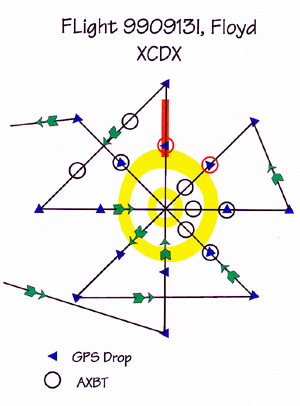| Lead Project Scientist | Dr. Hugh Willoughby |
| AXBT Scientist | Dr. Liz Ritchie |
| Workstation Scientist | Paul Leighton |
| Dropsonde Scientist | Neal Dorst |
| Guest | Dr. Kristine Katsaros |
 Two AXBT's on the downwind leg reported 28.8° and 28.7°C
SST ahead of the storm. The nominal track on the second
penetration was due east, perpendicular to the first
penetration. We reached the center at 2113 and deployed
eyewall drops on entrance and exit. We continued beyond the
eye to a point 103 nmi the east of the center and turned
downwind to the north-northwest in order to rotate the second
figure 4 by 45°. An AXBT 60 nmi from the center on the
outbound leg reported a 26.3°C SST. The third penetration was
from northeast to southwest. AXBTs on this leg showed SSTs of
26.1° and 26.8°C behind and to the right of the storm's
motion. We reached the center at 2236 and again deployed
eyowall drops. On exit through the southwest eyewall, we
encountered moderate turbulence in a 17 m/s updraft. At a
point ~100 nmi out we turned downwind to the east to pass
south of the center to the start of the final penetration from
southeast to northwest. As we broke out of the eyewall into
the eye we saw the new moon low over the western eyewall and
bright stars overhead. We reached the center 30 nmi NW of San
Salvador at 0021 UT on the 14th and observed a 923 mb MSLP by
dropsonde. N43RF recovered at Miami International at 0153.
Two AXBT's on the downwind leg reported 28.8° and 28.7°C
SST ahead of the storm. The nominal track on the second
penetration was due east, perpendicular to the first
penetration. We reached the center at 2113 and deployed
eyewall drops on entrance and exit. We continued beyond the
eye to a point 103 nmi the east of the center and turned
downwind to the north-northwest in order to rotate the second
figure 4 by 45°. An AXBT 60 nmi from the center on the
outbound leg reported a 26.3°C SST. The third penetration was
from northeast to southwest. AXBTs on this leg showed SSTs of
26.1° and 26.8°C behind and to the right of the storm's
motion. We reached the center at 2236 and again deployed
eyowall drops. On exit through the southwest eyewall, we
encountered moderate turbulence in a 17 m/s updraft. At a
point ~100 nmi out we turned downwind to the east to pass
south of the center to the start of the final penetration from
southeast to northwest. As we broke out of the eyewall into
the eye we saw the new moon low over the western eyewall and
bright stars overhead. We reached the center 30 nmi NW of San
Salvador at 0021 UT on the 14th and observed a 923 mb MSLP by
dropsonde. N43RF recovered at Miami International at 0153.
Equipment: Airplane worked well, but instrumentation
problems compromised the mission. The LF radar never observed
realistic reflectivities, apparently due to AFC problems.
Handshaking problems between AVAPS and the workstation
prevented transmission of all but the first three dropsondes.
Ten minutes downtime on the main data system cost us uniform
spatial coverage. Eight of ten AXBTs worked, and all of the
GPS sondes worked, at least partially.
Critique: Floyd was essentially in a steady state
during an eyewall replacement after an episode of rapid
deepening on the previous day. Average storm motion during the
flight was 11 kt toward 290° This is a unique data set,
compromised by equipment problems.